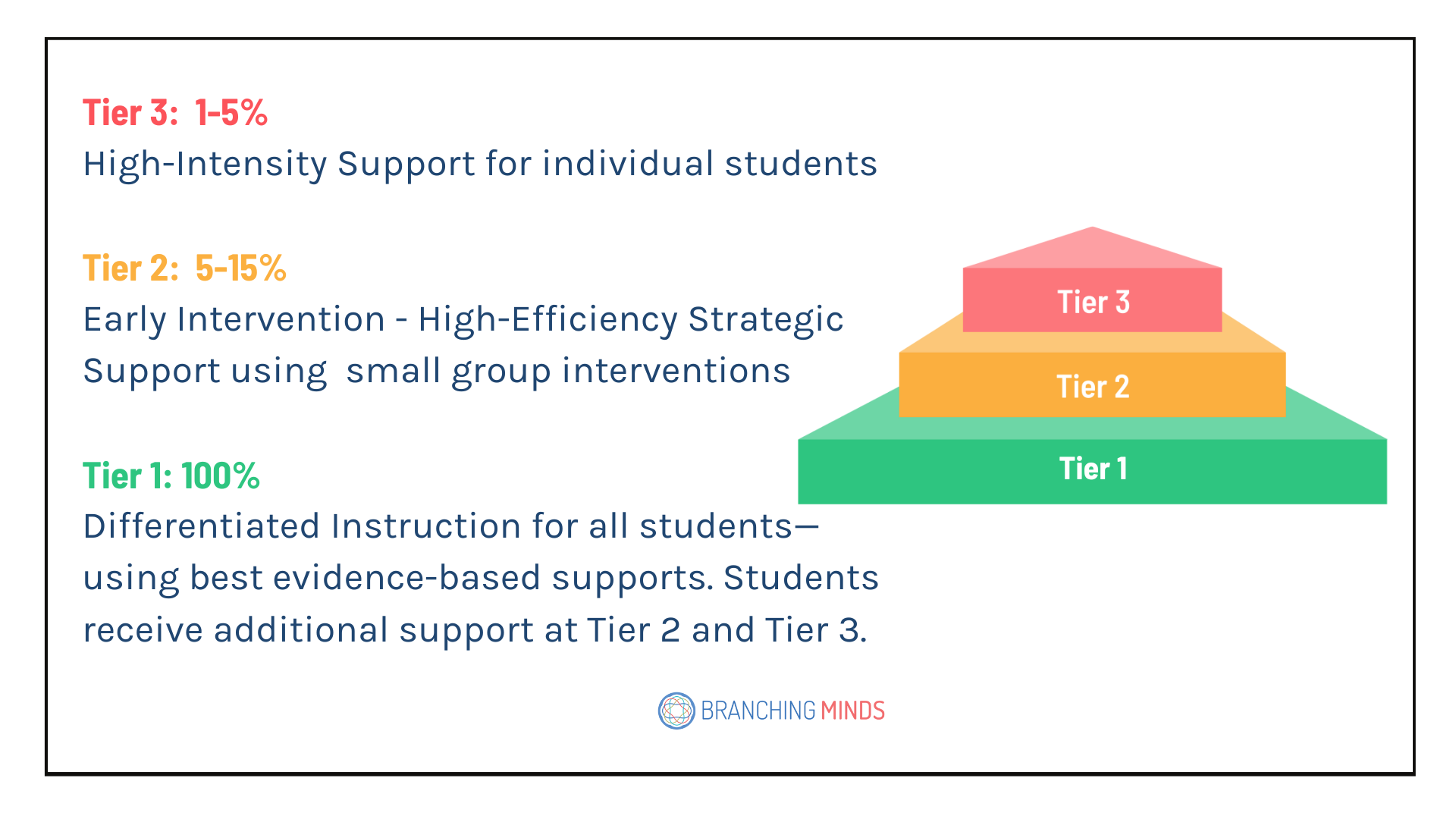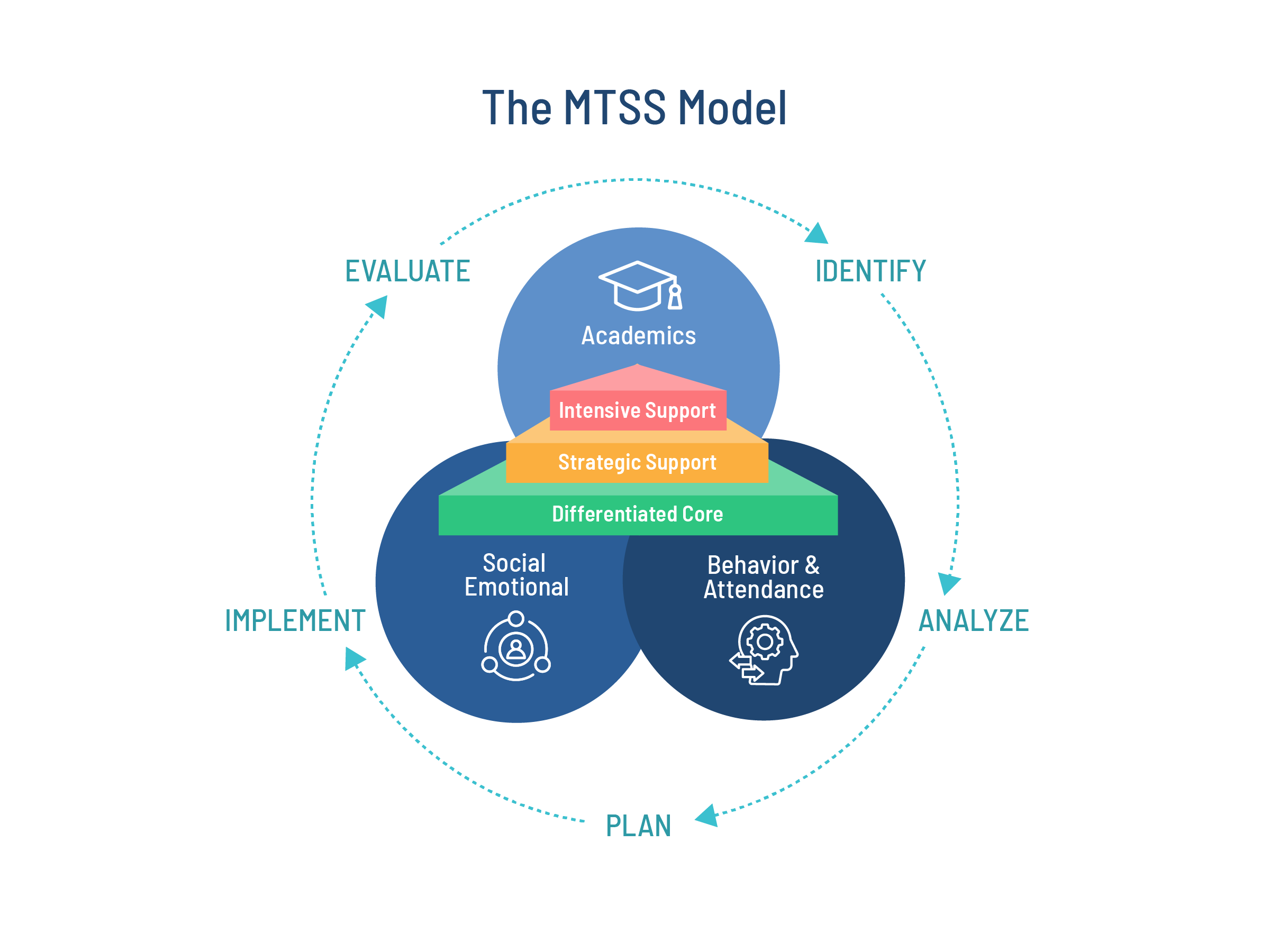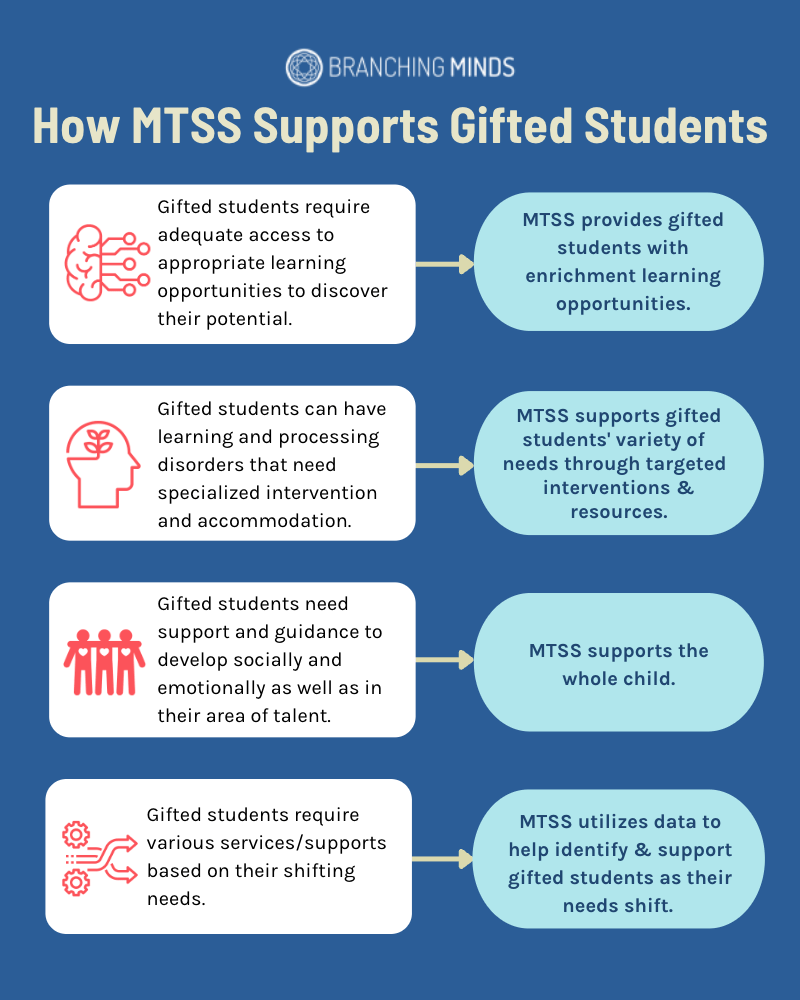The U.S. Department of Education's Office of Civil Rights estimates that six percent of public school students are enrolled in gifted and talented programs.
As many as 3.6 million gifted children are being overlooked in school — more than the 3.3 million U.S. public school children already labeled as gifted.
Hechinger Report
The Multi-Tiered System of Supports (MTSS) is a framework that supports all students—students below grade level, students at grade level, and students above grade level in need of enrichment.
But how do we identify gifted students? How do we find and provide the right accelerated enrichment support programs for gifted students? How do we even know if these supports are working and how do we adjust supports if they’re not working? And how can we do all of this objectivity?
Before we get lost in the frantic fray of Google search results, let’s take a step back and see how the Multi-Tiered System of Supports (MTSS) can help districts and schools support gifted students. You may have heard that MTSS can help scaffold support for struggling students to meet grade-level standards, but have you heard that MTSS can also provide advanced learning and enrichment support for gifted and talented students?
In this article, I’ll offer a quick refresher on the definitions of MTSS and gifted students; then we’ll go over what gifted students need, and finally, break down how MTSS supports gifted students, and share some helpful resources along the way. Let’s get to it!
MTSS Supports Gifted Students: Key Takeaways
- Gifted students require adequate access to appropriate learning opportunities to discover their potential and MTSS provides gifted students with enrichment learning opportunities.
- Gifted students can have learning and processing disorders that need specialized intervention and accommodation and MTSS supports this variety of needs through targeted evidence-based interventions and resources.
- Gifted students need support and guidance to develop socially and emotionally, as well as in their area of talent and MTSS supports the whole child.
- Gifted students require various services/supports based on their shifting needs, and MTSS utilizes data to help identify and support gifted students as their needs shift.
What is MTSS?
The Multi-Tiered System of Supports (MTSS) is a system-level structure that provides academic, behavioral, social-emotional, and attendance support for all students. In MTSS, data are gathered and utilized to address academic and non-academic needs, such as attendance and social-emotional concerns, ensuring a holistic approach to support.
There are three tiers in MTSS:
- Tier 1: whole class data-driven differentiated core instruction,
- Tier 2: whole-class differentiated instruction + small group targeted instruction (in addition to core instruction), and
- Tier 3: whole class core differentiated instruction + additional targeted instruction (often small group in addition to core instruction) + intensive support.
MTSS is commonly discussed with the focus on providing interventions for at-risk students not meeting grade-level standards. Yet, the MTSS pyramid provides the same structural tiered support approach to gifted and talented students needing enrichment.

Who Are Gifted Students?
According to the National Association for Gifted Students (NAGS), “Gifted individuals are those who demonstrate outstanding levels of aptitude (defined as an exceptional ability to reason and learn) or competence (documented performance or achievement in top 10% or rarer) in one or more domains. Domains include any structured area of activity with its own symbol system (e.g., mathematics, music, language) and/or set of sensorimotor skills (e.g., painting, dance, sports).”
Gifted students can also be referred to as “asynchronous learners,” as they can have significant variations in cognitive, physical, and emotional development within themselves and develop unevenly across skill levels. With this distinction, it’s important to remember that the traits of one gifted child may be extremely different from another, so there is no one-size-fits-all approach for gifted children.
Identification of Gifted Students
It’s important to note that gifted students come from all ethnic, cultural, and racial populations and all economic classes. The percentage of students served in gifted education programs doesn’t reflect the general student population.
According to an article published by the Associated Press in 2021, a recent analysis of the most recent federal data indicated that nationwide, 8.1% of white and 12.7% of Asian American children in public schools are considered gifted, compared with 4.5% of Hispanic and 3.5% of Black students.
White students are often provided more access to gifted programs. “In its own recent analysis, Seattle public schools found only 0.9% of Black children had been identified as gifted, compared with 12.6% of its white students,” for its Highly Capable Cohort gifted program.
There is controversy around having gifted programs, with some calling them “exclusive and exclusionary.” This is because most gifted and talented programs have depended on tests to decide eligibility, and some families spend thousands of dollars on tutoring and expensive specialized programs to boost scores and increase their children’s chances of obtaining a coveted spot.
MTSS creates an inclusive learning environment for all students, where students needing enrichment begin to receive those resources immediately after universal screening assessments.
What Do Gifted Students Need?
Need #1: Gifted students require adequate access to appropriate learning opportunities to discover their potential.
It’s imperative that gifted students have opportunities in early education to participate in challenging and/or enriched programs. And schools need to consider the context of the individual's previous opportunities to learn, not just grade-level performance.
Gifted and talented students who aren’t appropriately challenged are at a higher risk of dropping out of high-achieving groups during elementary and secondary school. This is because these students grow disengaged with learning and are sometimes flagged as “failing students.” For those in lower socioeconomic circumstances, this can more often be the case due to a lack of adequate identification.
Need #2: Gifted students can have learning and processing disorders that need specialized intervention and accommodation.
Some gifted students are considered to be twice-exceptional, meaning they are gifted and talented while also having a disability such as Attention Deficit Hyperactivity Disorder (ADHD), Autism Spectrum Disorder (ASD), dyslexia, etc. It’s crucial that these students have accurate and timely identification to ensure they receive the right social-emotional and/or academic support.
Need #3: Gifted students need support and guidance to develop socially and emotionally as well as in their area of talent.
Gifted students can also require support for social-emotional development. Educators and parents of gifted students need to provide and foster holistic social-emotional learning (SEL). Emotional regulation, self-perception, social skills, ability to cope with challenges and handle criticism, willingness to take strategic risks, motivation, and confidence should all be taken into consideration.
Need #4: Gifted students require various services/supports based on their shifting needs.
A gifted and talented student will often need a fluid/readily adjustable framework of support, because their needs and educational environments change over time. Needs can also differ among gifted students based on readiness for advanced curriculum and support. It’s important to note that these needs are on a continuum in both cognitive and affective areas.
How Does MTSS Support Gifted Students’ Needs?
The short answer is that MTSS is a layered continuum of supports for all students—whether below grade level, at grade level, or above grade level—in academic, social-emotional, and behavioral growth. And the framework assists in identifying students who are in need of supplemental instruction and/or enriched instruction.
MTSS Provides Gifted Students with Enrichment Learning Opportunities
Need #1: Gifted students require adequate access to appropriate learning opportunities to discover their potential.
One of the biggest concerns for gifted students is that if they’re not challenged in the everyday classroom at Tier 1, they are at risk of becoming disengaged from learning and potentially failing and/or dropping out. And this doesn’t mean they lack a skill level, but because the instruction isn't meeting their needs and they grow uninterested.
In MTSS, gifted students often receive individualized instruction or practice appropriate for their higher skill level. That way, they remain engaged at the Tier 1 level.
For example, they might be placed in small groups in Tier 2 that contain enrichment opportunities that build upon the Tier 1 curriculum (such as moving through content at a faster or deeper pace, doing projects, accessing advanced course material, etc.). At Tier 3, these students will continue to be in Tier 1, but they will also be in an individualized program that allows them to work with higher-level material and with a gifted support teacher.
The table below shows enrichment opportunities for each tier level.
|
Tier Level |
Tier Objective |
Enrichment Opportunities at Each Tier |
|
Tier 1 |
Students receive differentiated core instruction in the classroom. |
Differentiating core instruction and the classroom, such as:
|
|
Tier 2 |
Students receive targeted supplemental interventions in addition to core instruction. Used to support gifted students who require enrichment to stay engaged in the classroom. |
|
|
Tier 3 |
Students receive intensive interventions and support in addition to core instruction. Used to support gifted students who require enrichment to stay engaged in the classroom. |
|
MTSS Supports Gifted Students' Variety of Needs Through Targeted Evidence-Based Interventions and Resources
Need #2: Gifted students can have learning and processing disorders that need specialized intervention and accommodation.
Some gifted students may need enrichment in one subject area; while also needing support in another subject area where they aren’t meeting grade-level standards. For example, a student may be gifted in math and need enrichment in that area while also being below grade level in English and needing more intervention support in that area.
MTSS Supports the Whole (Gifted) Child
Need #3: Gifted students need support and guidance to develop socially and emotionally as well as in their area of talent.

MTSS integrates academics with social-emotional learning and behavioral learning.
Remember, gifted students may need a variety of services/supports based on their shifting needs, whether that be social-emotional, behavioral, or academic. The comprehensive framework of MTSS best ensures gifted students receive well-rounded support in areas they need enrichment and areas they need help.
MTSS Utilizes Data to Help Identify & Support Gifted Students
Need #4: Gifted students require various services/supports based on their shifting needs.
In addition to supporting the whole child, MTSS is a continuous data analysis system. As students’ needs shift, they are proactively identified with universal screening assessments to determine what level of support they need to continue to make progress in their learning.
Intervention plans provide targeted resources for all students receiving tiered support, including students requiring extra challenging material from core curriculum. Progress monitoring assessment tools provide guidance by determining if intervention plans are effective.
➡️ Learn more about MTSS and Assessment Data
It’s important to note that gifted and talented students need frequent assessments to ensure that they are receiving the “just-right” support, not too difficult and not too easy. This is especially true if they skip a grade level or are identified as needing Tier 3 enrichment support.
Understandably, it can be overwhelming for a school or district to track all of this assessment data and find the “just-right” course of enrichment and/or interventions if they are below grade level in other subject areas.
An MTSS Management platform, such as Branching Minds, helps keep track of assessment data and progress monitoring data and presents to help you identify gifted students in need of enrichment, collaborate on surveys to determine the root of each unique student’s challenges, and streamline documentation to quickly understand student progress and areas of need.

What Does Supporting Gifted Students Through MTSS Look Like in Practice?
To stay engaged, gifted students need appropriate pace and level of complexity, opportunity to demonstrate mastery, time with others of like-ability, high levels of thinking, both critical and creative, acceptance, respect, encouragement, and feelings of success with hard work.
Tier 1 for Gifted Students
Tier 1 core instruction should be differentiated for all learners, including gifted students. Differentiated instruction should be supplied to accelerate/deepen learning for gifted students to maximize their achievement as part of core instruction.
It’s important to note that differentiated instructional practice for gifted and talented learners must often contain higher-order thinking and questioning, additional open-ended assignments, preference, and proof and reasoning.
According to Bertie Kingore in Differentiation: Simplified, Realistic, and Effective; How to Challenge Advanced Potentials in Mixed-Ability Classrooms, some guidelines for creating a differentiating learning atmosphere for gifted learners are to:
- Promote success for all students as they learn important information in different ways.
- Encourage respect, responsibility, ownership, and pride.
- Allow students to polish and refine their craft.
- Recognize where each student begins, and enable each to experience as much progress as possible.
- Invite challenge and complexity in both thought and production.
- Integrate high-order thinking, including the encouragement of abstract thinking and symbolism.
- Involve students in planning and organizing learning. Extend students from consumers to producers.
Tier 2 for Gifted Students
In Tier 2, students can receive targeted supplemental interventions in addition to core instruction. Tier 2 instruction can provide enrichment for gifted learners by being systematic, explicit, and aligned with ongoing universal tier instruction. It parallels what is going on in Tier 1 (the everyday classroom) with adjustments to abstraction, complexity, pace, and depth.
Tier 2 enrichment is based on individual needs. However, instructional interventions are delivered in small groups of students with similar strengths, interests, or needs as determined by assessments and observations.
The key is observing and assessing each advanced learner’s progress based on their potential. Once a teacher understands what progress is transpiring during the gifted student’s period in the classroom, recommendations can form for supplementary interventions to assist the student in achieving their full potential.
Tier 3 for Gifted Students
Students who will need Tier 3 enrichment are highly or exceptionally gifted. Accelerated support options can range from curriculum compacting in the regular grade-level classroom to skipping whole grades to early entrance to college. Less intensive forms of acceleration (such as curriculum compacting) may occur in Tier 1 or Tier 2.
Students in need of Tier 3 enrichment require a curriculum that differs greatly in pace, level, complexity, and abstraction from same-age peers. Tier 3 enrichment may take place in addition to Tier 2 supplemental enrichment and Tier 1 enriched differentiated instruction, or it may supersede it altogether. If a student’s support services shift from Tier 1 and Tier 2 to intensive in Tier 3, the core curriculum should be examined to pinpoint gaps in learning.
For some gifted students, standard differentiation and instructional management/delivery are not adequate. The higher the IQ or ability of the gifted student, the more acceleration and modifications must be put in place to preserve the balance between the student and curriculum.
Why is it Important to Properly Identify and Support Gifted Students?
Without the proper identification and support, gifted students may never reach their full potential and eventually become disengaged, leading to low grades and/or even dropping out.
And just as there have been many students demonstrating the need for Tier 2 and Tier 3 support by not meeting grade-level standards due to the interruptions caused by remote learning from COVID-19, gifted students also haven’t received the equivalent level of enriched instructional programs/support during COVID-19 learning interruptions.
While there is no easy-fix-all solution to objectively identify and support gifted students, a framework such as MTSS can help schools and districts recognize when a student needs enriched support.
Check out these organizations for more information on gifted students:
➡️ National Association for Gifted Children
➡️ The Association for the Gifted
➡️ Supporting Emotional Needs of the Gifted
Citations:
- Kingore, B. W. (2004). Differentiation: Simplified, realistic, and effective: How to challenge advanced potentials in mixed-ability classrooms. Professional Associates Pub.
- https://opi.mt.gov/Gifted-and-Talented-Education-Educators
- https://sites.google.com/opiconnect.org/gifted-education/gifted-mtss
- https://www.edsurge.com/news/2021-08-03-the-strange-past-and-messy-future-of-gifted-and-talented?utm_campaign=EdSurgeSproutSocial&utm_medium=social&utm_source=twitter.com
- https://www.giftedpage.org/wp-content/uploads/2018/11/MTSS-PowerPoint-Slides.pdf
- https://hechingerreport.org/up-to-3-6-million-students-should-be-labeled-gifted-but-arent/
- https://apnews.com/article/new-york-education-new-york-city-united-states-race-and-ethnicity-f8cbdb50edba9802fe9ad503cfe7d467
- https://www.st-clair.net/Data/Sites/1/media/public/SpecialEd/gifted-program/differentiation-and-enrichment-strategies-for-gifted-students.pdf
- https://opi.mt.gov/Portals/182/Page%20Files/Gifted%20and%20Talented%20Education/Educators/MTSS%20Tier%202.pdf?ver=2021-05-12-125644-857
- https://opi.mt.gov/Portals/182/Page%20Files/Gifted%20and%20Talented%20Education/Educators/MTSS%20Tier%203.pdf?ver=2021-05-12-125644-873#:~:text=Tier%203%20refers%20to%20evidence,IQ%20of%20145%20or%20greater

Your MTSS Transformation Starts Here
Enhance your MTSS process. Book a Branching Minds demo today.














![[Guest Author] Lindsay McCance-avatar](https://www.branchingminds.com/hs-fs/hubfs/lindsay-mccance.png?width=82&height=82&name=lindsay-mccance.png)



.png?width=716&height=522&name=Addressing%20Foundational%20Reading%20Skills%20in%20MTSS%20(preview).png)